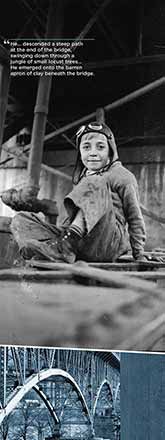Bridges Hiding the other side of Knoxville
McCARTHY, Suttree: “He crossed into the city and
descended a steep path at the end of the bridge,
swinging down through a jungle of small locust
trees… He emerged onto the barren apron of clay
beneath the bridge. Small black children playing
there in the cool.”
“Under the high cool arches and dark keeps of
the span’s undercarriage. Glancing up at these
cathedraled vaultings with their fossil woodknots
and pseudomorphic nailheads in gray concrete.”
SCHWARZENBACH: “The bridges that lead into
Knoxville span high above the river. It is a city
like many others, 200 years old, with a red-brick
markethouse where farmers sell apples and
tomatoes as well as corn and peppers. A city with
shops and cinemas, a Main Street ablaze with light,
and dark quarters where the workers of hosiery
factories have to live in sheer poverty.”
Bridges Hiding the other side of Knoxville
 McCARTHY, Suttree: “He crossed into the city and
descended a steep path at the end of the bridge,
swinging down through a jungle of small locust
trees… He emerged onto the barren apron of clay
beneath the bridge. Small black children playing
there in the cool.”
McCARTHY, Suttree: “He crossed into the city and
descended a steep path at the end of the bridge,
swinging down through a jungle of small locust
trees… He emerged onto the barren apron of clay
beneath the bridge. Small black children playing
there in the cool.”
“Under the high cool arches and dark keeps of
the span’s undercarriage. Glancing up at these
cathedraled vaultings with their fossil woodknots
and pseudomorphic nailheads in gray concrete.”
SCHWARZENBACH: “The bridges that lead into
Knoxville span high above the river. It is a city
like many others, 200 years old, with a red-brick
markethouse where farmers sell apples and
tomatoes as well as corn and peppers. A city with
shops and cinemas, a Main Street ablaze with light,
and dark quarters where the workers of hosiery
factories have to live in sheer poverty.”


...the journey seems to me less an adventure and a foray into unusual realms than a concentrated likeness of our existence: residents of a city, citizens of country, beholden to a class or a social circle...
— Annemarie Schwarzenbach —